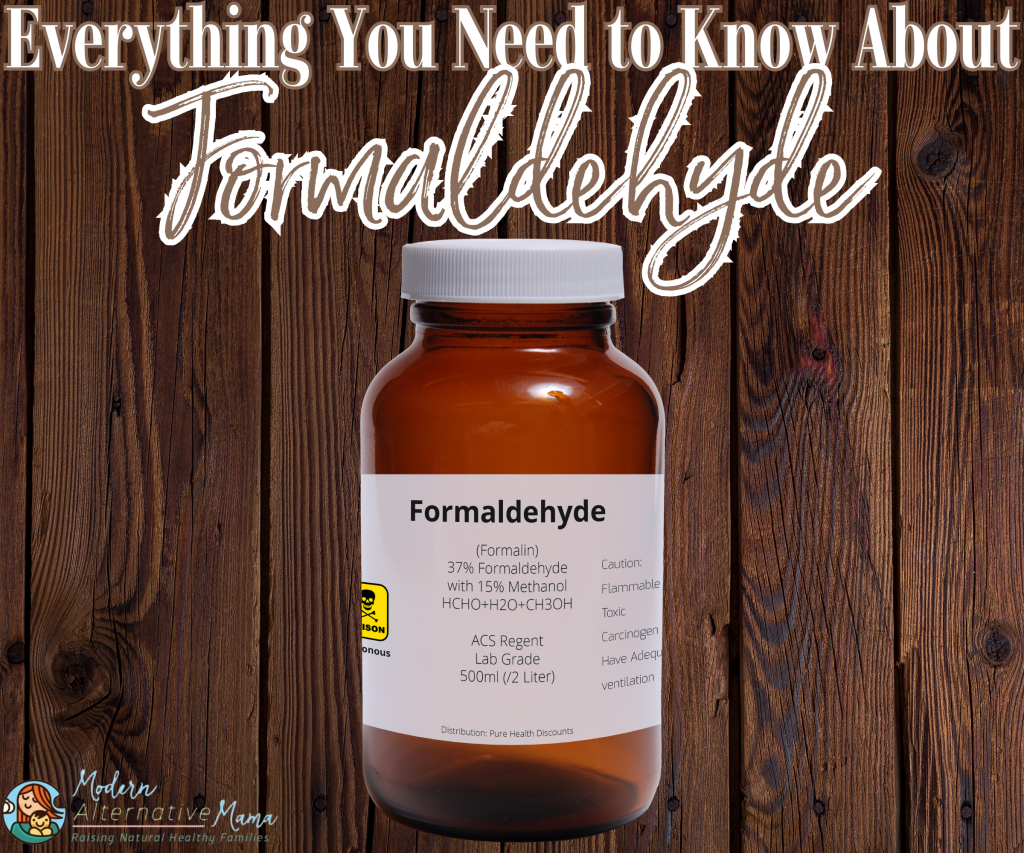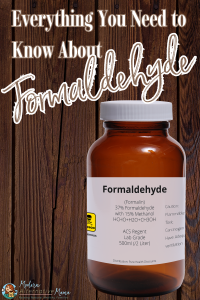As someone with a social media following surrounding vaccine education, I’ve quickly learned that many people do not understand the basics of formaldehyde. As someone with a documented formaldehyde allergy, I’d like to set some things straight.
Firstly, there are two types of formaldehyde, naturally occurring and synthetically made. So understanding the difference between the two formaldehyde types and the difference between ingestion and injection is crucial. According to the American Cancer Society:
“Formaldehyde is a strong-smelling, colorless gas used in making building materials and many household products. It is used in pressed-wood products, such as particleboard, plywood, and fiberboard; glues and adhesives; permanent-press fabrics; paper product coatings; and certain insulation materials. It is also used to make other chemicals (1).”
Everything You Need to Know About Formaldehyde
As mentioned earlier, there are two types of formaldehyde – naturally occurring and synthetically made, and the two couldn’t be more different.
Naturally occurring formaldehyde is a carbon, hydrogen, and oxygen substance. Naturally occurring formaldehyde is found in every living organism, from humans to animals and plants, as a part of the metabolic process (2).
Contrarily, synthetically made formaldehyde is a combination of methyl alcohol vapors, and the air is passed over a platinized asbestos, copper, or silver catalyst (3). Let’s look at the dangers of asbestos, copper, and silver.
First up, we have asbestos. We’ve all seen the compensation commercials for Johnson & Johnson’s talcum powder. Asbestos is known to cause mesothelioma, pleural thickening, asbestosis, asbestos-related lung cancer, ovarian cancer, and laryngeal cancer (4). Approximately 90,000 people die from asbestos-related diseases globally each year an estimated 125 million people worldwide remain at risk of occupational exposure to asbestos (5)!
Next up, we have copper and silver. When we think about heavy metals, we typically think of the top five that rank highest in toxicity –arsenic, cadmium, chromium, lead, and mercury (6). If you read our blog, Everything You Need to Know About Heavy Metals, you know there are thirty other metals of concern (18 are heavy metals), and both copper and silver are on that list (7). Ironically, I am allergic to silver (amongst many other metal alloys), which is likely why I am allergic to synthetically derived formaldehyde.
Now that you know the difference between naturally occurring and synthetically derived formaldehyde, let’s learn how to avoid it by knowing all its hidden names like (8):
- Formalin
- Formic aldehyde
- Methaldehyde
- Methyl aldehyde
- Methylene oxide
- Methanal
- Oxymethylene
If you’re like me and allergic to formaldehyde or just wish to lower your formaldehyde exposure, I’d recommend avoiding the following chemicals as they’re formaldehyde releasers (8):
- Quaternium-15
- Diazolidinyl urea (Germall® II)
- DMDM hydantoin (Glydant)
- Imidazolidinyl urea (Germall®)
- 2-bromo-2-nitropropane-1,3-diol
And finally, let’s discuss where synthetically derived formaldehyde is added, like:
- Shampoos
- Conditioners
- Lotions
- Body washes
- Hair styling products
- Hair dyes
- Perms
- Nail polishes
- Household cleaners (learn more about other toxic ingredients in household cleaners)
- Laundry detergents (learn more about other toxic ingredients in laundry detergents)
- Furniture
- Vaccines (learn more about the Gardasil vaccine and polio vaccine)
- Cigarettes
Formaldehyde is even added as a preservative in food, similar to how it preserves dead bodies when used in embalming. Formaldehyde can also be produced from cooking and smoking (1).
Dangers of Synthetic Formaldehyde
Now that we know the difference between natural and synthetic formaldehyde, other names for formaldehyde, and where each is found, let’s discuss the dangers of synthetically derived formaldehyde. According to the Minnesota Department of Health, short-term exposure to formaldehyde can cause coughing, headaches, dizziness, nausea, and eye, nose, and throat irritation (9), but that’s just the start.
Based on toxicological data and epidemiological evidence obtained in workplaces, formaldehyde has been a categorized group 1 carcinogen for humans since 2004 (10). A categorized group 1 carcinogen is implemented when there is sufficient evidence of carcinogenicity in humans (11).
Additionally, The Centers for Disease Control & Prevention (CDC) recognizes the risks of formaldehyde. They state that “Exposure to formaldehyde can irritate the skin, throat, lungs, and eyes. Repeated exposure to formaldehyde can possibly lead to cancer (12).” So how is this ingredient allowed in our food supply, vaccines, and almost every household and cosmetic product? Other health risks associated with formaldehyde exposure include:
Allergies
Some people are naturally allergic to airborne formaldehyde. Even studies acknowledge that formaldehyde is a common trigger for allergic contact dermatitis (ACD) (13). Allergic reactions aside, some people may develop a formaldehyde allergy due to skin contact with liquid formaldehyde (14). With that said, in Europe, where there are stricter guidelines on formaldehyde use, only about 1.5% to 2.5% of adults have an allergy. Contrarily, in the United States, where formaldehyde is in many of our household and cosmetic products, we have an 8% allergy rate (15).
Asthma
Several studies have linked formaldehyde exposure to the risk of developing asthma. A 2002 study found domestic exposure to formaldehyde significantly increased the risk of childhood asthma (16). A systematic review had similar findings, concluding, “Results indicate a significant positive association between formaldehyde exposure and childhood asthma (17).”
A more recent study demonstrated formaldehyde exposure in school classrooms of inner-city was significantly associated with rhinitis, peripheral olfactory dysfunction, increased pharmacologically reversible nasal obstruction, small airway impairment, and asthma (18). Additionally, a 2021 systematic review, meta-analysis, and economic assessment had similar findings of 90 studies reviewed, confirming formaldehyde exposure was associated with increased childhood asthma diagnosis. They also noted exacerbating asthma symptoms in children and adults (19).
Bronchitis & Pneumonia
Aside from causing respiratory diseases like asthma, formaldehyde can also cause respiratory illnesses. A 1905 study reported formaldehyde’s toxic effects, stating that even in small quantities, formaldehyde exposure can lead to bronchitis and pneumonia (20). Even mainstream sources acknowledge that repeated formaldehyde exposure can cause bronchitis (21). Additionally, a systematic review with meta-analysis confirmed formaldehyde exposure was associated with increased complaints of cough, phlegm production, asthma, chronic bronchitis, and colds (22).
Cancer
Earlier, we briefly discussed how formaldehyde is carcinogenic, so we know formaldehyde is a class 1 carcinogen. Even mainstream sources like The National Cancer Institute acknowledge that high levels of formaldehyde exposure cause myeloid leukemia and rare cancers, including cancers of the paranasal sinuses, nasal cavity, and nasopharynx (23).
One study found formaldehyde has a leukemia-inducing mechanism via oxidative stress (24). Another study found exposure to formaldehyde and wood dust increased the risk of nasopharyngeal cancer (25). It’s important to note that this study does not mention if the wood was formaldehyde treated, but chances are, like most wood composites, it was (26).
It’s important to note that some people, like myself, are very sensitive to formaldehyde. A sensitive individual may have negative effects at lower levels than expected, whereas others may not react when exposed to the same levels of formaldehyde (27).







